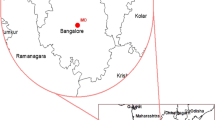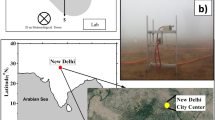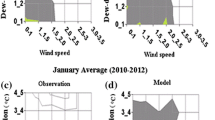Abstract
Accurate forecasts of fog and visibility are very important to air and high way traffic, and are still a big challenge. A 1D fog model (PAFOG) is coupled to MM5 by obtaining the initial and boundary conditions (IC/BC) and some other necessary input parameters from MM5. Thus, PAFOG can be run for any area of interest. On the other hand, MM5 itself can be used to simulate fog events over a large domain. This paper presents evaluations of the fog predictability of these two systems for December of 2006 and December of 2007, with nine regional fog events observed in a field experiment, as well as over a large domain in eastern China. Among the simulations of the nine fog events by the two systems, two cases were investigated in detail. Daily results of ground level meteorology were validated against the routine observations at the CMA observational network. Daily fog occurrences for the two study periods was validated in Nanjing. General performance of the two models for the nine fog cases are presented by comparing with routine and field observational data. The results of MM5 and PAFOG for two typical fog cases are verified in detail against field observations. The verifications demonstrated that all methods tended to overestimate fog occurrence, especially for near-fog cases. In terms of TS/ETS, the LWC-only threshold with MM5 showed the best performance, while PAFOG showed the worst. MM5 performed better for advection–radiation fog than for radiation fog, and PAFOG could be an alternative tool for forecasting radiation fogs. PAFOG did show advantages over MM5 on the fog dissipation time. The performance of PAFOG highly depended on the quality of MM5 output. The sensitive runs of PAFOG with different IC/BC showed the capability of using MM5 output to run the 1D model and the high sensitivity of PAFOG on cloud cover. Future works should intensify the study of how to improve the quality of input data (e.g. cloud cover, advection, large scale subsidence) for the 1D model, particularly how to eliminate near-fog case in fog forecasting.















Similar content being viewed by others
References
Bergot, T., Carrer, D., Noilhan, J., and Bougeault, P. (2005), Improved site-specific numerical prediction of fog and low clouds: a feasibility study, Weather and Forecasting 20, 627-646.
Bergot, T., Terradellas, E., Cuxart, J., Mira, A., Liechti, O., Mueller, M., and Nielsen, N.W. (2007), Intercomparison of Single-Column Numerical Models for the Prediction of Radiation Fog, J. Appl. Meteor. Climatology 46, 504–521.
Bott, A., Sievers, U., and Zdunkowski, W. (1990), A radiation fog model with a detailed treatment of the interaction between radiative transfer and fog microphysics, J. Atmos. Sci. 47(18), 2153-2166.
Bott, A. and Trautmann, T. (2002), PAFOG-a new efficient forecast model of radiation fog and low-level stratiform clouds, Atmos. Res. 64,191-203.
Burrows, W.R., and Toth, G. (2011), Automated fog and stratus forecasts from the Canadian RDPS operational NWP model, 24th Conference on Weather Analysis and Forecasting, AMS, Seattle, Washington, USA, 23-27 January, 2011.
Chaumerliac, N., Richard, E., and Pinty, J.-P. (1987), Sulfur scavenging in a mesoscale model with quasi-spectral microphysics: Two-dimensional results for continental and maritime clouds, J. Geophys. Res. 92(D3), 3114-3126.
Fu, G., Guo, J., Xie, S.P., Duan, Y., and Zhang, M. (2006), Analysis and high-resolution modeling of a dense sea fog event over the Yellow Sea, Atmos. Res. 81(4), 293-303.
Gao, S., Lin, H., Shen, B., and Fu, G. (2007), A heavy sea fog event over yellow sea in March 2005: Analysis and Numerical Modeling, Advances in Atmospheric Sciences 24(1), 65-81.
Grell, G.A., Dudhia, J., and Stauffer, D.R. (1994), A description of the fifth generation Penn State/NCAR Mesoscale Model (MM5), NCAR Tech. Note NCAR/TN-398+STR, Natl. Cent for Atmos. Res., Boulder, Colo.
Gultepe, I., Tardif, R., Michaelides, S. C., Cermak, J., Bott, A., Bendix, J., Muller, M.D., Pagowski, M., Hansen, B., Ellrod, G., Jacobs, W., Toth, G., Cober, and S.G. (2007), Fog Research: A Review of Past Achievements and Future Perspectives, Pure and Applied Geophysics 164, 1420-9136.
Gultepe, I., Pearson, G., Milbrandt, J.A., Hansen, B., Platnick, S., Taylor, P., Gordon, M., Oakley, J. P., and Cober S.G. (2009), The fog remote sensing and modeling field project, Bulletin of the American Meteorological Society 90(3), 341-359.
Jacobs, W., Michaelides, S.C., Nietosvaara, V., Bott,A., Bendix, J., and Cermak, J. (2005). Short range forecasting methods of fog, visibility and low clouds, Second Midterm Workshop, Langen, Germany, 20 October.
Kong, F. (2002), An experimental simulation of a coastal fog-stratus case using COAMPS (tm) model, Atmos. Res. 64, 205-215.
Kunkel, B. A. (1984), Parameterization of droplet terminal velocity and extinction coefficient in fog models, Journal of Climate and applied meteorology 23(1), 34-41.
Lin, Y. (2010), The parameterizations and numerical study of visibility during the fog in the winter of Nanjing and probabilistic forecast of visibility, Master Dissertation of Nanjing University of Information Science & Technology (in Chinese).
Liu, X, Zhang, H., Li Q. and Zhu, Y. (2005), Preliminary research on the climatic characteristics and change of fog in China, Journal of Applied Meteorological Sciences (in Chinese) 16(2), 220-271.
Liu, D., Pu, M., Yang, J., Zhang, G., Yan, W. and Li Z. (2009), Microphysical structure and evolution of four-day persistent fogs around Nanjing in December 2006, Acta Meteorologica Sinica (in Chinese), 67(1), 147-157.
Liu, D., Yang, J., Niu, S. and Li, Z. (2011), On the evolution and structure of a radiation fog event in Nanjing, Advances in Atmospheric Science, 28(1), 223-237.
Lu, R., Turco, R.P. and Jacobson M.Z. (1997), An integrated air pollution modeling system for urban and regional scales: 2. Simulation for SCAQS 1987, J. Geophys Res, 102(5), 6081-6098.
Lu, C., Niu, S., Tang, L., Lv, J., Zhao, L. and Zhu B. (2010), Chemical composition of fog water in Nanjing area of China and its related fog microphysics, Atmospheric Research 97(1), 47-69.
Mellor, G.L. and Yamada, T. (1974), A hierarchy of turbulence closure models for planetary boundary layers, J. Atmos., Sci., 31(7), 1791-1806.
Miao, Y., Potts, R., Huang, X., Elliott, G., Rivett, R. and Manickam, M. (2010), Application of Fuzzy-Logic NWP Fog Guidance to Perth Fog Forecasting Decision Support System, 5th International Conference on Fog, Fog Colloection and Dew, Munster, Germany, 25-30 July, 2010.
Muller, M.D., Schmutz, C. and Parlow, E. (2007), A one-dimensional Ensemble Forecast and Assimilation System for Fog Prediction, Pure and Applied Geophysics 164, 1241-1264.
Nickerson, E.C., Richard, E., Rosset, R. and Smith, D.R. (1986), The numerical simulation of clouds, rain, and airflow over the Vosges and Black Forest mountains: a meso-β model with parameterized microphysics, Monthly Weather Review 114, 398-414.
Niu, S., Lu, C., Yu, H., Zhao, L. and Lu J. (2010), Fog Research in China: An Overview, Advances in Atmospheric Sciences 27(3), 639-661.
Otte, T. L. (2008), The Impact of Nudging in the Meteorological Model for Retrospective Air Quality Simulations: Part I: Evaluation against National Observation Networks, J. Appl. Meteor. and Clim. 47, 1853-1867.
Pielk, R.A. (1984), Mesoscale Meteorological Modeling, Academic Press, Orlando 612 pp.
Pu, M., Zhang, G., Yan, W. and Li, Z. (2008), Features of a rare advection-radiation fog event, Science in China Series D: Earth Sciences 51(7), 1-9.
Siebert, J., Bott, A. and Zdunkowski, W. (1992a), Influence of a vegetation-soil model on the simulation of radiation fog, Beitr. Phys. Atmos. 65, 93-106.
Siebert, J., Sievers, U. and Zdunkowski, W. (1992b), A one-dimensional simulation of the interaction between land surface processes and the atmosphere, Boundary–Layer Meteorology, 59, 1-34.
Shi, C., Roth, M., Zhang, H., and Li, Z. (2008), Impacts of urbanization on long-term fog variation in Anhui Province, China, Atmos. Environ. 42, 8484-8492.
Shi, C., Yang J., Qiu M., Zhang, H., Zhang, S., and Li, Z. (2010), Analysis of an extremely dense regional fog event in Eastern China using a mesoscale model, Atmospheric Research 95(4), 428-440.
Stoelinga, M. T. and Warner, T. T. (1999), Nonhydrostatic, Mesobeta-Scale Model Simulations of Cloud Ceiling and Visibility for an East Coast Winter Precipitation Event, J. Appl. Meteor. 38(4), 385-404.
Tardif, R. (2007), The impact of vertical resolution in the explicit numerical forecasting of radiation fog: A case study, Pure and Applied Geophysics 164, 1221-1240.
Tong, Y., Yin, Y., Xu, X., Xu, M. and Xiang, Y. (2009), Climatological characteristics of fogs in Nanjing, Journal of Nanjing Institute of Meteorology (in Chinese) 32(1), 115-120.
Van Der Velde, I.R., Steeneveld, G.J., Wichers Schreur, B.G.J. and Holtslag, A.A.M. (2010), Modeling and forecasting the onset and duration of severe radiation fog under frost conditions, Mon. Wea. Rev. 138, 4237-4253.
WMO (1992), International Meteorological Vocabulary, WMO 182.
Wu, D., Deng, X., Ye, Y. and Mao, W. (2004), The study on fog water chemical composition in Dayaoshan of Nanling mountain, ACTA Meteorologica SINICA (in Chinese) 62(4), 476-485.
Wu, D., Deng, X., Mao, J., Mao, W., Ye, Y., Bi, Y., Tang, H., and Wan, Q. (2007), A study on macro- and micro-structures of heavy fog and visibility at freeway in the Nanling Dayaoshan mountain, ACTA Meteorologica SINICA 65(3), 406-415.
Yang, J., Xie, Y., Shi, C., Liu, D., Niu, S. and Li, Z. (2009), Differences in Ion compositions of winter fog water between radiation and advection-radiation fog episodes in Nanjing, Transactions of Atmospheric Sciences (in Chinese) 32, 776-782.
Yang, J., Niu, Z., Shi, C., Liu, D., and Li, Z. (2010a), Microphysics of Atmospheric Aerosols During Winter Haze/Fog Events in Nanjing, Environmental Science (in Chinese) 31(7), 1425-1431.
Yang, J., Wang, L., Liu D. and Li, Z. (2010b), The boundary layer structure and evolution mechanisms of a deep dense fog event, Acta Meteorologica Sinica (in Chinese) 68(6), 998-1006.
Zdunkowski, W.G., Panhans, W.-G., Welch, R.M. and Korb, G.J. (1982), A radiation scheme for circulation and climate models, Beitr. Phys. Atmos. 55, 215-238.
Zhou, B. and Ferrier, B.S. (2008), Asymptotic analysis of equilibrium in radiation fog, Journal of Applied Meteor and Clim. 47, 1704-1722.
Zhou, B. and Du, J. (2010), Fog prediction from a multi-model mesoscale ensemble prediction system, Wea. Forecasting 25, 303-322.
Zhou, B., Du J., Gultepe I. and Dimego G. (2011), Forecast of Low Visibility and Fog From NCEP-Current Status and Efforts, this issue.
Zhou, Z., Zhu, Y., and Ju, X. (2007), Dense fog events in the Yangtze Delta and their climatic characteristics, Progress in Natural Science 17(1), 66-71.
Zehnder J. A. (2002), Simple modifications to improve Fifth-Generation Pennsylvania State University–National Canter for Atmospheric Research Mesoscale Model Performance for the Phoenix, Arizona, Metropolitan Area, Journal of Applied Meteorology 41, 971-979.
Acknowledgments
This work was supported by funds from the National Natural Science Foundation of China (40775010), Project of New Technology Application of China Meteorology Agency (CMATG2010M16) and the Special Funds for Public Welfare of China (Grant No. GYHY200906012). We sincerely thank Professor Bott for providing the code of PAFOG and are grateful to the anonymous referees’ valuable suggestions.
Author information
Authors and Affiliations
Corresponding author
Rights and permissions
About this article
Cite this article
Shi, C., Wang, L., Zhang, H. et al. Fog Simulations Based on Multi-Model System: A Feasibility Study. Pure Appl. Geophys. 169, 941–960 (2012). https://doi.org/10.1007/s00024-011-0340-0
Received:
Revised:
Accepted:
Published:
Issue Date:
DOI: https://doi.org/10.1007/s00024-011-0340-0




